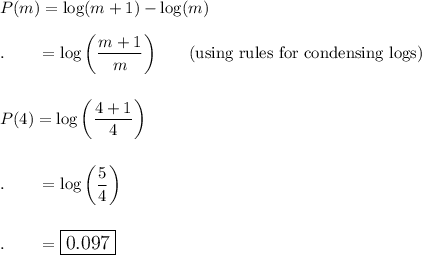
Mathematics, 09.03.2020 09:55 nickwwe13
Benford's Law states that the probability that the first decimal-digit of a raw data sample (from 1 to 9) is given
Pm = log (m +1) - log m. That is, about (100P)% of the data can be expected to have m as the first digit. Complete parts a and b below.
a. What percent of the data can be expected to have 4 as the first digit?
Pa =
(Round to three decimal places as needed.)
b. Find P1+P2 + ... + P9. Interpret your result.
Py + P2 + ... +P9 =
(Type an integer or a decimal.)

Answers: 3


Other questions on the subject: Mathematics

Mathematics, 21.06.2019 18:30, ashleytellez
41/17 as a decimal rounded to the nearest hundredth
Answers: 1

Mathematics, 21.06.2019 20:00, ElizabethF
Aball is dropped from a height of 10m above the ground. it bounce to 90% of its previous height on each bounce. what is the approximate height that the ball bounce to the fourth bounce?
Answers: 2


Mathematics, 22.06.2019 03:00, davelopez979
Which is the graph of the following inequality?
Answers: 3
You know the right answer?
Benford's Law states that the probability that the first decimal-digit of a raw data sample (from 1...
Questions in other subjects:

Law, 29.01.2021 23:20



History, 29.01.2021 23:20

Social Studies, 29.01.2021 23:20





Mathematics, 29.01.2021 23:20






